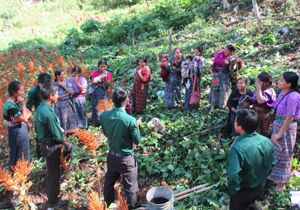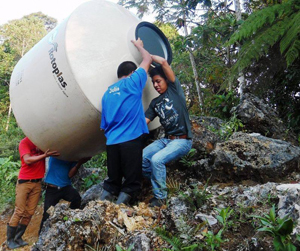
When educators think of technology, they most often think of digital tools—computers, iPhones, and the Internet, for example. Students need these technologies to learn, but they can also learn from technologies behind (or on top of) the school building and around the grounds.
In this TILE SIG post, we invite you to meet some courageous teachers, students, and volunteers, who, through a desire to learn and serve their communities, transformed a single school into a thriving community of educational energy, cultural celebration, and purpose. Welcome to Maya Jaguar Center for Education.
These protagonists teach, study, and volunteer at Maya Jaguar—a rural school high in the mountains of Guatemala. Among the first technologies installed were solar panels that continue to power lights, internet connections, and computers. With the school lit and connected to the world via the internet, students can read, write, and create in ways they could not before. Many students come from villages without access to electricity. Moreover, the twin technologies of electrification and internet aid students in mastering Spanish, their second language, and the language of the school curriculum. (Most of the students speak an indigenous first language, Q’anjob’al, a Mayan dialect). Technology further allows the students to develop critical thinking skills while bringing the best practices of the world beyond northern Guatemala to their villages.
 Teachers assigned to bridge the world of school and the surrounding communities guide students in their internet searches to consult with agronomists in Guatemala and the United States to identify the most sustainable gardening practices. One project offers outreach to village schools and families to grow amaranth, a source of protein that is desperately needed in this region. Because of the success of this program, Maya Jaguar Center staff and village mothers are considering a move forward to add peanuts, a high-protein crop, which is not grown in the region. It will supplement the nutrition initiatives already in place.
Teachers assigned to bridge the world of school and the surrounding communities guide students in their internet searches to consult with agronomists in Guatemala and the United States to identify the most sustainable gardening practices. One project offers outreach to village schools and families to grow amaranth, a source of protein that is desperately needed in this region. Because of the success of this program, Maya Jaguar Center staff and village mothers are considering a move forward to add peanuts, a high-protein crop, which is not grown in the region. It will supplement the nutrition initiatives already in place.
Although students reside in a rain forest at Maya Jaguar, potable water is hard to access. By building on local knowledge, eco-technologies, and the skill of faculty and students, the school now boasts a reliable rain catchment program that provides safe water to the campus. Because Maya Jaguar teachers and students have deep roots throughout the villages, the sustainable technologies of school gardens, solar energy, and other green or eco-friendly practices every step forward is multiplied ten-fold.
 Technology means tools, the implements that humans use to improve their lives and connect with other human beings. Though the tools of electrification, gardening, and access to potable water may seem fundamental, they are ultimately relevant to the literacies of life found in every aspect of reading the meaningful texts of the world. Texts may be words on a page, but they also include knowledge of how local resources may be used to best meet the fundamental needs of a population. Technology serves to help individuals critically evaluate the vast network of expertise that is available through digital environments beyond the community. It can also help build bridges that preserve indigenous cultures and helping village leaders and community members to look to a future that belongs to them.
Technology means tools, the implements that humans use to improve their lives and connect with other human beings. Though the tools of electrification, gardening, and access to potable water may seem fundamental, they are ultimately relevant to the literacies of life found in every aspect of reading the meaningful texts of the world. Texts may be words on a page, but they also include knowledge of how local resources may be used to best meet the fundamental needs of a population. Technology serves to help individuals critically evaluate the vast network of expertise that is available through digital environments beyond the community. It can also help build bridges that preserve indigenous cultures and helping village leaders and community members to look to a future that belongs to them.
At schools where students face the challenges of healthy water and food supplies, Maya Jaguar’s teachers and students have found the right combination of new literacies, cultural traditions, and global citizenship.
Photos courtesy of The Adopt-a-Village in Guatemala Foundation.
 Thomas DeVere Wolsey is an educational consultant who focuses on literacy and technology development at home and internationally.
Thomas DeVere Wolsey is an educational consultant who focuses on literacy and technology development at home and internationally.
 Frances Dixon is the founder and president of Adopt-a-Village in Guatemala, a nonprofit foundation dedicated to education, nutrition, and agriculture for indigenous populations in Guatemala.
Frances Dixon is the founder and president of Adopt-a-Village in Guatemala, a nonprofit foundation dedicated to education, nutrition, and agriculture for indigenous populations in Guatemala.
This article is part of a series from the International Literacy Association Technology in Literacy Education Special Interest Group (TILE-SIG).